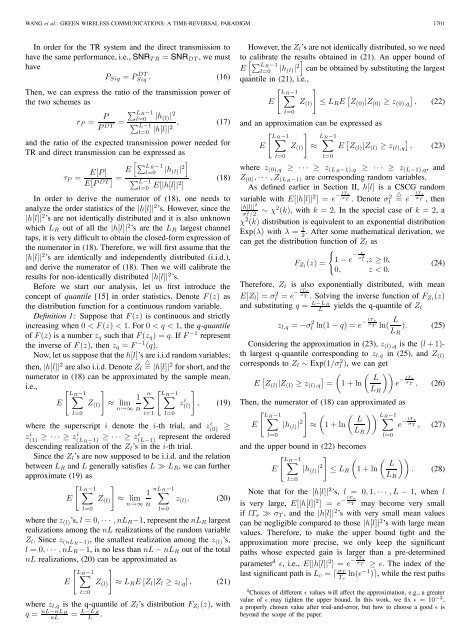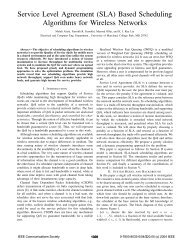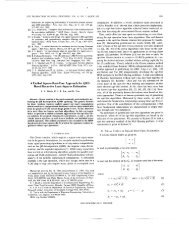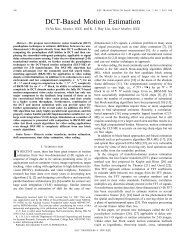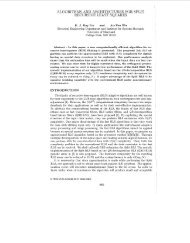Green Wireless Communications: A Time-Reversal Paradigm
Green Wireless Communications: A Time-Reversal Paradigm
Green Wireless Communications: A Time-Reversal Paradigm
You also want an ePaper? Increase the reach of your titles
YUMPU automatically turns print PDFs into web optimized ePapers that Google loves.
WANG et al.: GREEN WIRELESS COMMUNICATIONS: A TIME-REVERSAL PARADIGM 1701<br />
However, the Z ’s are not identically distributed, so we need<br />
In order for the TR system and the direct transmission to<br />
q = nL−nLR<br />
nL<br />
= L−LR<br />
L . beyond the scope of the paper.<br />
l<br />
have the same performance, i.e., SNR TR = SNR DT ,wemust [ calibrate the results obtained in (21). An upper bound of<br />
∑LR−1<br />
]<br />
have<br />
E<br />
P Sig = PSig DT<br />
l=0<br />
|h (l) | 2 can be obtained by substituting the largest<br />
. (16) quantile in (21), i.e.,<br />
[<br />
Then, we can express the ratio of the transmission power of<br />
LR−1<br />
]<br />
∑<br />
the two schemes as<br />
E Z (l) ≤ L R E [ ]<br />
Z (0) |Z (0) ≥ z (0),q , (22)<br />
r P =<br />
P<br />
∑ LR−1<br />
P DT = l=0<br />
|h (l) | 2<br />
l=0<br />
∑ L−1<br />
, (17) and an approximation can be expressed as<br />
l=0<br />
|h[l]|2 [ LR−1<br />
]<br />
∑<br />
L∑<br />
R−1<br />
and the ratio of the expected transmission power needed for E Z (l) ≈ E [ ]<br />
Z (l) |Z (l) ≥ z (l),q , (23)<br />
TR and direct transmission can be expressed as<br />
l=0<br />
l=0<br />
[ ∑LR−1<br />
]<br />
τ P = E[P ] E<br />
E[P DT ] = l=0<br />
|h (l) | 2 where z (0),q ≥ ··· ≥ z (LR−1),q ≥ ··· ≥ z (L−1),q , and<br />
∑ L−1<br />
. (18) Z (0) , ··· ,Z (LR−1) are corresponding random variables.<br />
l=0 E[|h[l]|2 ]<br />
As defined earlier in Section II, h[l] is a CSCG random<br />
In order to derive the numerator of (18), one needs to variable with E[|h[l]| 2 ]=e − lTs<br />
σ T . Denote σ 2 △<br />
l = e − lTs<br />
σ T ,then<br />
analyze the order statistics of the |h[l]| 2 ’s. However, since the |h[l]| 2<br />
|h[l]| 2 σl ’s are not identically distributed and it is also unknown<br />
(k), with k =2. In the special case of k =2,a<br />
which L R out of all the |h[l]| 2 χ 2 (k) distribution is equivalent to an exponential distribution<br />
’s are the L R largest channel<br />
Exp(λ) with λ = 1 2<br />
. After some mathematical derivation, we<br />
taps, it is very difficult to obtain the closed-form expression of<br />
can get the distribution function of Z l as<br />
the numerator in (18). Therefore, we will first assume that the<br />
|h[l]| 2 ’s are identically and independently distributed (i.i.d.),<br />
F<br />
and derive the numerator of (18). Then we will calibrate the<br />
Zl (z) =<br />
{1 − e − z<br />
σ<br />
l 2 ,z ≥ 0,<br />
(24)<br />
0, z < 0.<br />
results for non-identically distributed |h[l]| 2 ’s.<br />
Before we start our analysis, let us first introduce the Therefore, Z l is also exponentially distributed, with mean<br />
concept of quantile [15] in order statistics. Denote F (z) as E[Z l ]=σl<br />
2 = e − lTs<br />
σ T . Solving the inverse function of F Zl (z)<br />
the distribution function for a continuous random variable. and substituting q = L−LR<br />
L<br />
yields the q-quantile of Z l<br />
Definition 1: Suppose that F (z) is continuous and strictly<br />
increasing when 0


